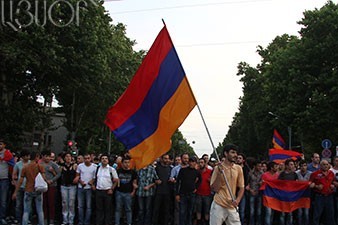
03/07/2015 11:46
Seeing conspiracies in Armenia where none exist. Editorial. Washington Post
Last month, Armenia’s electricity monopoly, which is owned by a Russian conglomerate headed by one of Vladimir Putin’s cronies, was granted a big price increase by a government commission. Protesters took to the streets, chanting “no to plunder”; when they were attacked by riot police with water cannons, a much bigger crowd took over Yerevan’s main avenue. They are still there. Mostly young and leaderless, the demonstrators haven’t articulated a political agenda, and Western governments have kept their distance. The U.S. embassy in Yerevan limited itself to a tweet urging “peaceful restrained behavior.”
Mr. Putin’s propaganda apparatus, however, has been quick to draw conclusions. Russian media said the U.S. embassy had orchestrated the protests to replicate last year’s popular revolution in Ukraine. “You know how the color revolutions, and the Maidan in Ukraine started,” said Foreign Minister Sergei Lavrov. That was a reference to the Kremlin’s favorite conspiracy theory: that the popular uprisings in Kiev and other Eurasian capitals were not spontaneous but meticulously fomented by the CIA.
What’s most remarkable about this deluded reaction is that it is not mere bombast. Consumed by cynicism and paranoia, Mr. Putin and the circle around him appear to regard any manifestation of unrest within Russia or the neighboring states it aspires to dominate as the product of secret plots. The possibility that Armenians, an impoverished people whose leaders have sold most of their economy to Russia, might be genuinely aggrieved at a 17 percent electricity price increase imposed by an opaque, Moscow-based cartel is dismissed within the Kremlin as naive.
Armenian President Serge Sarkisian, though a Russian client, is not quite so out of touch. While publicly rejecting the idea that the protests were anti-Russian, Mr. Sarkisian did his best to defuse them after the police attack failed. He said that the state would cover the cost of the price increase while the electricity monopoly was subjected to an audit, and hinted that the company might be nationalized or resold. He also extracted $200 million in fresh military aid from Moscow, as well as a promise that a Russian soldier accused of murdering an Armenian family would be turned over to the local justice system.
That failed to end the protests, and Mr. Sarkisian’s decision to align his government with the Putin regime is looking shortsighted. Armenia last year became just the third country, after Belarus and Kazakhstan, to join the Eurasian Economic Union, Mr. Putin’s attempt to create a Moscow-dominated bloc. During a visit to Washington in May, Mr. Sarkisian told us the decision was pragmatic: Armenians working in Russia provide a fifth of the country’s gross domestic product, and Russia is its sole energy supplier. “Armenian cognac can’t really be sold in Paris,” he added.
Now, however, Armenia and other clients are suffering from Russia’s economic crash. The decline of the ruble has dragged down Armenia’s currency, while the plummeting profits of energy conglomerate Inter RAO UES, chaired by U.S. sanctions target Igor Sechin, have pushed it to extract more revenue from its Armenian subsidiary. In short, Armenians don’t need American prompting to revolt; Mr. Putin and his gang are providing plenty of impetus.








